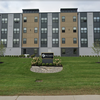GCSD gets $530K approved in Smart Schools funds
Enterprise file photo
Pioneer: Molly Fanning, an English teacher at Farnsworth Middle School, works with one of her students on a Chromebook. In 2014, Fanning won the Technology in Education Award for Farnsworth, incorporating technology into most of her lessons. Her students created digital memoirs and worked collaboratively on poems and essays.
GUILDERLAND — By September, Guilderland school leaders expect, each middle school and each high school student will have a Chromebook laptop.
“Every child will have a device at their disposal,” said Demian Singleton, the district’s assistant superintendent for instruction. “It’s a very big step. It levels the playing field,” he said, explaining that currently, some students and some classrooms don’t have access to computers.
The governor’s office on Monday announced that another $34 million of the $2 billion Smart Schools Bond Act was approved. The Guilderland schools were approved for $531,447 of which the lion’s share — $498,723 — will go for classroom technology, including buying the new Chromebooks.
Another $32,724 will be used for school connectivity.
Each district’s Smart Schools request is reviewed by a board made up of the state’s commissioner of education, MaryEllen Elia; the chancellor of the state university system, Kristina M. Johnson; and the state’s budget director, Robert Mujica. Singleton said that it had been a year-and-a-half since Guilderland submitted its request in the two categories approved this week.
The $32,724 will be used to upgrade the digital broadcast system at Farnsworth Middle School. “We have a TV studio for our student media broadcasts,” said Singleton, noting that students broadcast every school day. “We’ve been patching it with Band-Aids … The equipment is on its last legs.”
A four-year replacement cycle will be set up for Guilderland’s Chromebooks. At the high school, for example, the newest ones will be given to ninth-graders; sophomores will get one-year-old devices; juniors, two-year-old Chromebooks; and seniors, three-year-old Chromebooks.
Each student will keep his or her device throughout high school. “Similar to textbooks, they’ll be allowed to take them home,” said Singleton. The devices, at home or wherever they are used, will have the same security in place that they would if used in the school, he said.
Having Chromebooks for every student changes classroom management, Singleton said. “May teachers use Google Classroom; it’s a largely paperless environment,” he said. “Students can submit work digitally.”
Guilderland started using Google Apps for Education in 2009. In 2013, the district started using Chromebooks in a pilot project at the high school where teachers applied to receive a full set of 30 to use in their classes.
Natalia LeMoyne, Guilderland’s coordinator for instructional technology, told The Enterprise earlier how technology has changed the role of a teacher. “She is no longer the source of information or knowledge,” said LeMoyne. “The teacher is a guide that helps students navigate information and to think deeper and use abstract reasoning.”
LeMoyne summed up her philosophy saying, “Given the age we’re now in, having a teacher recite facts and having kids regurgitate those facts is not productive. Facts and information are a kid’s fingertips. A teacher’s job is to teach kids to evaluate, to use higher-order thinking levels .... Communication amongst teachers is what makes the light bulbs go off.”
Singleton went on to describe a number of ways in which using the devices changes learning. “Digital literacy skills can be developed in multiple disciplines,” Singleton said.
Also, collaboration is emphasized when students use Google Docs. “Multiple students work together on a single document,” he said. He went on, “There’s general access to resources. Textbooks as the primary source of information is waning quickly.”
Also, Singleton said, “Students rely on networks of peers or of experts in the field.” And finally, Singleton said, there are changes in “the creation and curation of information.” He explained, “Students are able to create or compose in the moment, not having to wait to get to a computer lab.”
The district plans to hold Parent Universities and Student Universities throughout the summer. “They can come in to learn about the care and use of the devices,” Singleton said. “We hope to distribute them over the summer so they can personalize them and become familiar with them,” he said of the Chromebooks.
He also said, “We’ll be doing a lot of professional development for the teachers.” This training will show the teachers effective ways to use the Chromebooks in their classrooms and for homework assignments.
A website will be developed, Singleton said, so that parents can access information about the Chromebooks.
Still ahead
When the Smart Schools bond went to statewide vote in 2014, Guilderland, a suburban district with roughly 5,000 students, was slated to get $2,096,732.
“We still have three projects awaiting approval,” said Singleton this week. A meeting was held on Wednesday, he said, to go over the logistics of the remaining projects. One is to replace all switches at the district’s five elementary schools.
Another is for “desktop virtualization,” Singleton said. He explained, “Rather than software on individual hard drives, it’s loaded on a centralized server.” This is important for advanced science, technology, engineering, and math courses at the high school in the Project Lead the Way program. “It will allow students to run high-power software on their Chromebooks,” said Singleton.
The third project is to “provide redundancy,” Singleton said. He explained, “It’s a way to make sure connectivity never goes down. Currently, we have just one connection at the high school, for the entire district. We’ll create a second point of connectivity at the middle school.”
In 2013, Guilderland voters passed a $17.3 million project to upgrade the district’s seven school buildings, which included $1.8 million for technology improvements, with the biggest portion, $618,000, spent on mobile labs.
“Technology is ever-changing,” said Singleton this week.
The district is currently working on developing another capital project, which would go to voters in October, he said, and technology will also be a component of that project.


